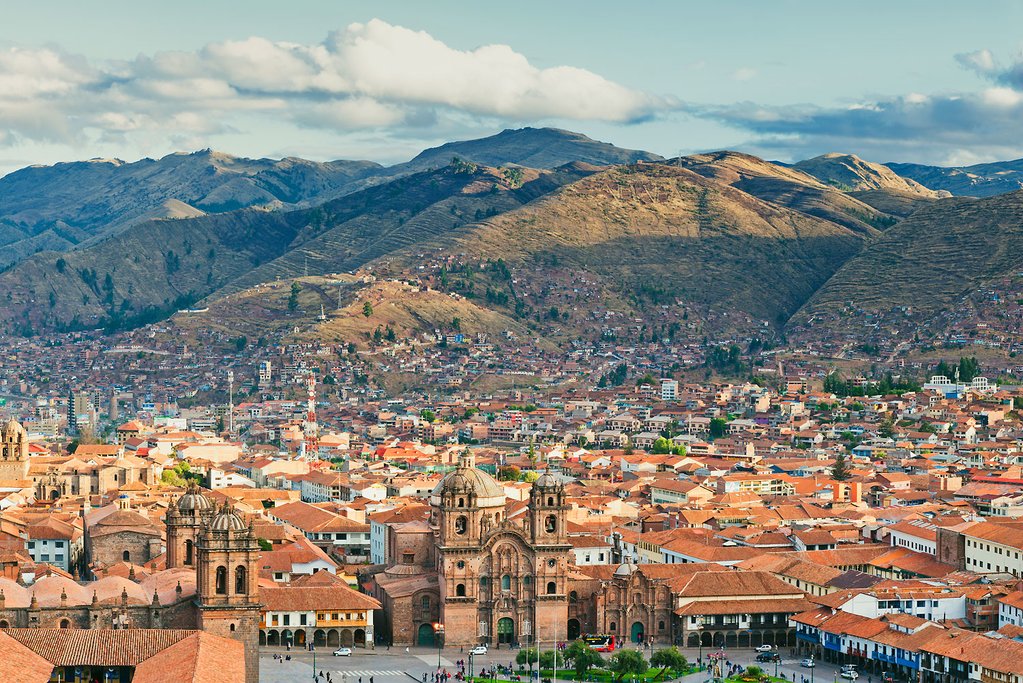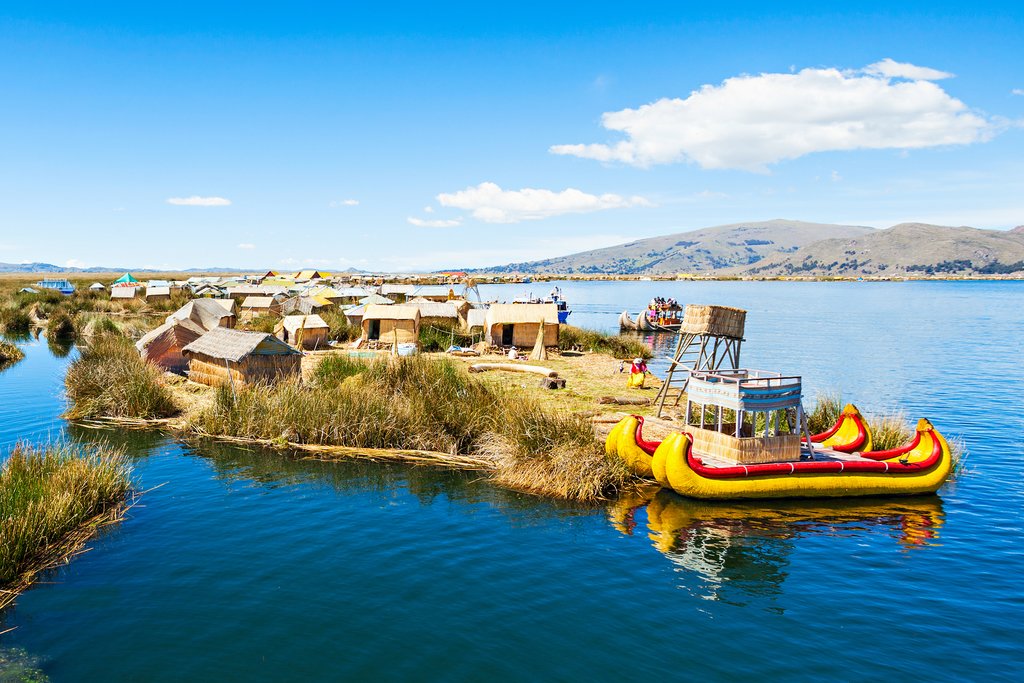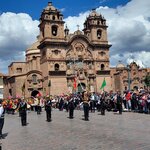Highlights
- Walk the streets of the ancient Inca capital of Cusco
- Explore the beauty and culture of the Sacred Valley
- Hike the legendary Inca Trail to Machu Picchu
- Delve into the culture and history of Lake Titicaca
Brief Itinerary
| Day | Highlights | Overnight |
|---|---|---|
| Day 1 | Arrive in Lima, Optional Activities | Lima |
| Day 2 | Fly to Cusco, Self-Guided Tour | Cusco |
| Day 3 | Sacred Valley Tour: Pisac to Ollantaytambo | Ollantaytambo |
| Day 4 | Inca Trail (Day 1): Ollantaytambo to Yuncachimpa | Yuncachimpa |
| Day 5 | Inca Trail (Day 2): Yuncachimpa to Chaquicocha | Chaquicocha |
| Day 6 | Inca Trail (Day 3): Chaquicocha to Wiñay Wayna | Wiñay Wayna |
| Day 7 | Inca Trail (Day 4): Wiñay Wayna to Machu Picchu | Cusco |
| Day 8 | Fly to Juliaca, Transfer to Puno & Lake Titicaca | Puno |
| Day 9 | Lake Titicaca Tour: Floating Islands & Taquile | Puno |
| Day 10 | Fly to Lima, Depart |
Chat with a local specialist who can help organize your trip.
Detailed Itinerary
Day 1: Arrive in Lima, Optional Activities

¡Bienvenidos! Welcome to Lima! Peru's largest city and capital is home to one-third of the country's population, but this cosmopolitan veneer belies a long and storied history. Upon arrival at the airport, a driver will pick you up at the terminal for the 30-minute drive into the city to your hotel in the trendy Miraflores district. After checking in, you can head out and discover this fascinating history and culture for yourself.
Lima sits on the site of a pre-Columbian Ychsma settlement, which was conquered by the Inca empire in the 15th century, and that, in turn, was later captured by Spanish conquistadores. In the intervening years, the country has seen much immigration. The result is a melting pot of a city whose eclectic history is complimented by a diverse mix of cultures, including Amerindian, European, Afro-Peruvian, and Asian (especially Chinese and Japanese) influences.
Lima's breezy location on the Pacific coast and its mild desert climate make it a perfect city for exploring on foot. If you like, begin a self-guided walking tour in the UNESCO-listed historic center and marvel at Spanish-colonial landmarks like the Lima Cathedral, which dates to 1535. For culture and history, head to Museo Larco, a museum that boasts a vast collection of pre-Columbian art and artifacts. Later in the day, return to Miraflores and Parque del Amor (Love Park), which sits on the coastal cliffs and is the perfect spot to enjoy an unforgettable sunset over the Pacific.
Day 2: Fly to Cusco, Self-Guided Tour

In the morning, you'll return to the airport in Lima and board a one-hour flight north to Cusco. Located high in the Andes at 11,200 feet (3,400 m), this area has been settled for thousands of years. However, it wasn't until 1200 CE that Cusco was officially founded as a center for Inca rule. It remained the capital of the Inca Kingdom until the Spanish conquest in the 16th century. Today this well-preserved historic city boasts an incredible mix of Spanish-colonial architecture and ancient Inca archaeological sites.
Upon arrival at the airport, a driver will be waiting to transfer you to your hotel in the city. After checking in, you can head out to discover Cusco on a self-guided tour—but take it slow, as the altitude will have an effect. Start at the Plaza de Armas, the city's main square, which is located in the historic center. Once a central meeting point during the Inca Empire, the Spanish founded the plaza in 1534, destroying and replacing the Inca buildings with colonial mansions and churches. The most famous of these is the Cusco Cathedral, which dates to 1654 and remains remarkably well-preserved.
From here, you can walk to nearby Inca sites. For example, a few blocks from the plaza is Qoricancha, the Temple of the Sun. During Inca reign in the 15th century, this was Cusco's religious and political center, and its interior walls were said to have been covered in gold. From here, you can wander the winding, cobbled streets of San Blas, a bohemian neighborhood with a wealth of Spanish-colonial landmarks, art galleries, handicraft shops, and cozy cafés.
Day 3: Sacred Valley Tour: Pisac to Ollantaytambo

Get ready for a full day of sightseeing in Peru. Wake up early and meet a guide before transferring north of Cusco to the Sacred Valley. Your first stop is the hilltop ruins overlooking the town of Pisac. Your guide will lead you around this archaeological site comprising Inca burial grounds, irrigation systems, and astronomy centers. Then head into town and visit Pisac's famous textile market. It's a great place to pick up a handmade garment to take home as a souvenir or gift.
Afterward, travel to Urubamba, the largest town in the Sacred Valley, where you'll stop for a traditional Peruvian lunch and a quick tour of the ruins of an Inca palace. From there, you'll visit the ancient city of Ollantaytambo, one of the few remaining places in the Sacred Valley that has retained its original Inca urban planning. As you walk amid the site, you'll witness marvels of early civil engineering in the form of ancient canals and Inca-era homes still in use today. You'll overnight here at a hotel in town.
Day 4: Inca Trail (Day 1): Ollantaytambo to Yuncachimpa

It's an early start today as you embark on the first leg of the famous Inca Trail trek to Machu Picchu. After breakfast in Ollantaytambo, you'll organize your gear and transfer to the trailhead at kilometer marker 82. There, you'll meet the group and begin the multiday trek. Today's route covers 6.8 miles (11 km) and takes 6-7 hours to complete.
It starts relatively easy as you cross the Urubamba River on an uphill ascent—a nice warm-up for the more strenuous sections coming in subsequent days. You'll reach the small community of Miskay by lunchtime, where you'll stop for a picnic by a river. After eating, explore the nearby archaeological site of Llactapata, then continue hiking to the grassy plains of Wayllabamba, located at 10,170 feet (3,100 m).
From there, ascend 700 feet (200 m) to Yuncachimpa, your campsite for the night. After setting up camp, you'll enjoy dinner amid impressive views of Waqaywillka (Veronica) Mountain and the surrounding landscapes.
Day 5: Inca Trail (Day 2): Yuncachimpa to Chaquicocha

Day two of the Inca Trail is a more challenging route that covers 9.3 miles (15 km) and takes 8-9 hours to complete. That said, you're free to go at your own pace, and there will be plenty of short rest breaks.
It starts with a steep 2-mile (3 km) trek through the Llulluchapampa Valley (1,263 ft/3,850 m). From there, follow the path for another 2-3 hours to Warmihuañusca Pass (11,3780 ft/4,200 m). Translated as "Dead Woman Pass," this section is (unsurprisingly) the hardest part of the trail.
After a break at the summit, you'll make the steep descent to the Pacaymayo River. There, cross Runkurakay Pass (10,007 ft/3,050 m) before reaching Chaquicocha, your campsite for the night. Here, at 11,975 feet (3,650 m), you can relax after a hard day on the trail and enjoy stunning views of the surrounding Andes peaks.
Day 6: Inca Trail (Day 3): Chaquicocha to Wiñay Wayna

The third day on the trail follows a more moderate route for 6.2 miles (10 km) and takes 5-6 hours to complete. There's much to see on this trail, as it will take you across various landscapes and past Inca ruins. Notice the change in ecosystems as you enter the tropical forest of Wiñay Wayna. Then pass several small lakes (and ancient Inca tunnels) as you make your way over a couple of mountain passes between 12,000-13,000 feet (3,700-3,950 m).
Eventually, you'll reach the Wiñay Wayna ruins. Translated as "Forever Young," this ancient Inca archaeological site is about 500 years old and is believed to have been a religious and agricultural center. To this end, the site consists of the ruins of terraces, agricultural structures, and stone buildings. From here, hike up ancient Inca stairs that turn into a zigzagging trail leading up to a red-roofed building—your last campsite. End the day with a hot, relaxing bath to soothe your tired muscles.
Day 7: Inca Trail (Day 4): Wiñayhuayna to Machu Picchu

This is it! The final leg of the Inca Trail to the ultimate destination! It's a very early start, with breakfast at 4:30 am. After eating, get back on the trail for the 4.3-mile (7 km) hike up to the famous Inti Punku (Sun Gate). You'll arrive just in time to marvel at sunrise views over Machu Picchu and its taller sibling Wayna Picchu. From there, it's a one-hour descent to the archaeological site, arriving around 8:00 am.
This 15th-century Inca citadel is located at 7,970 feet (2,430 m) and is a masterpiece of engineering that served as a sanctuary and retreat for the Inca Emperor Pachacutec and his royal court. Among other accolades, Machu Picchu has earned UNESCO World Heritage status and is one of the New Seven Wonders of the World. During a guided tour of the site, you'll hike to all corners of the complex and visit its most famous features and landmarks. These include astronomical/ritual stone structures like the Temple of the Sun and the Temple of the Moon.
After the official tour, you can explore on your own and admire other iconic landmarks, like the Sacred Plaza and Inca Bridge. The agricultural terraces are also impressive, demonstrating the Incas' skill at cultivating crops on steep hillsides. Later, catch a bus down to Aguas Calientes and soak your aches and pains away in the town's hot springs. Depart Aguas Calientes in the afternoon on a return trip to Cusco, where you'll check into a hotel and spend the rest of the day relaxing.
Day 8: Fly to Juliaca, Transfer to Puno & Lake Titicaca

In the morning, you'll transfer to the airport in Cusco for the one-hour flight south to Juliaca, a transit hub in the Puno region of Peru. From there, it's an hour's drive south to your hotel in the city of Puno, located on the shores of Lake Titicaca. Not only is this the largest body of water in South America, but Titicaca's elevation of 12,507 feet (3,812 m) makes it the highest accessible lake in the world.
This region is a hotbed of history, culture, and ecological diversity. Here, ancient archaeological sites sit alongside upscale hotels and Indigenous farming communities. For example, the coast outside Puno is home to the Uros people, who live on floating islands made from the totora plant, a thick, buoyant reed. Several other ethnic groups, most notably the Quechua and Taquileños, inhabit other, larger islands on the lake, most of which have no electricity or paved roads.
As for ecology, photographers and naturalists will enjoy spotting some of the many avian species and waterbirds here, which include ibises, hawks, and even flamingoes. However, It's a good idea to take it easy on your first day to acclimatize to the elevation. Drink lots of water and make sure to rest. Later, you can check out some of the town's restaurants and cafés for an authentic dining experience.
Day 9: Lake Titicaca Tour: Uros Floating Islands & Taquile

Make sure to eat a hearty breakfast this morning because you're off on a full-day tour around the lake. The first stop is at one of the floating Uros Islands. It is believed that the residents here–the Uros—were one of the first ethnic groups to populate the Andean region thousands of years before even the Incas. You'll learn about the Uros' culture and traditions during the visit. They're happy to share, as this Indigenous group supplements their hunting/fishing economy by offering guided tours of their island homes and selling traditional handicrafts.
After Uros, you'll board a boat for the ride to Taquile, a terrestrial island (not a floating one) on Lake Titicaca. Isolated from the outside world until the 1950s, it's home to Taquileños, a group of islanders who, like the Uros, adhere to their own customs and traditions. On the island, decisions are made communally, there are no cars, and there is very little electricity—just the way the Taquileños like it. Taquile is also famous for the hand-woven textiles created by local artisans. Traditionally, the men spin the thread while the women design and weave each piece.
After walking around the island, meeting residents, and learning about their culture, you'll return to the marina. Hop a boat back to Puno, where you'll have the evening free.
Day 10: Fly to Lima, Depart

You've had more than a few unforgettable adventures in Peru, and no doubt made lasting memories. In the morning, a driver will pick you up at your hotel for the ride to Juliaca Airport. There, you'll hop on a plane back to Lima and catch your international flight back home. ¡Buen viaje!
More Great Peru Itineraries
Looking for more inspiration for your trip to Peru? Check out these other Peru itineraries, explore other ways to spend 10 days in Peru, or learn about the best time to visit Peru.



